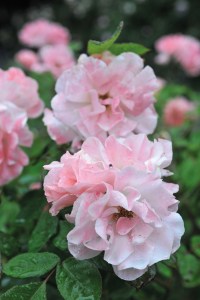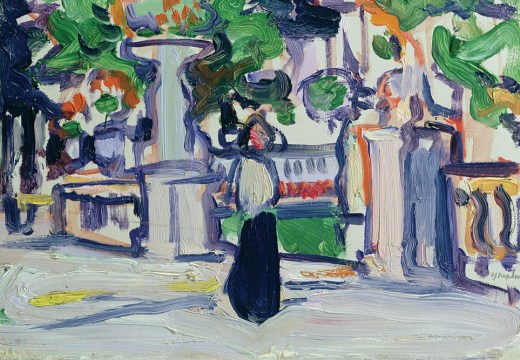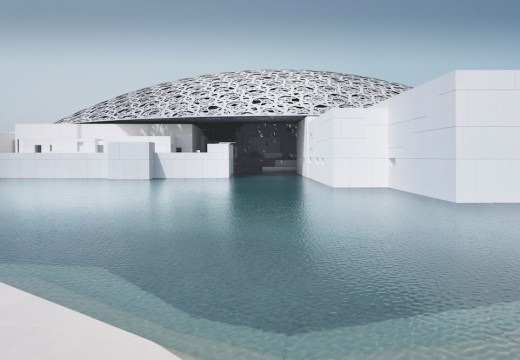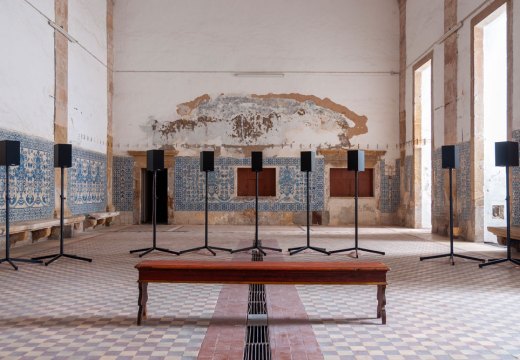From the September 2022 issue of Apollo. Preview and subscribe here.
‘The most urgent thing to do,’ wrote Vita Sackville-West about her garden, Sissinghurst, ‘was to plant hedges.’ Seventy years later, fashion designer Jil Sander would follow that advice in her own garden outside Hamburg. While she is renowned for her innovative fashion creations, Sander has carefully and painstakingly curated a contemporary garden shaped by English design, from Sackville-West’s Sissinghurst to the work of Russell Page and even William Kent’s use of focal points and perspective. Four ‘rooms’ sit alongside a carefully manipulated lake and landscape to create a garden that subtly updates and modernises traditional English taste. These photographs capture the garden at a particular moment in time. As Sander says, ‘We have been working on it for 40 years. It’s undergoing a constant metamorphosis.’
When did you become interested in gardens?
I have always been interested in nature and gardens. When I visited Sissinghurst as a young woman, it left a lasting impression on me. I kept it in my heart and was inspired to develop my personal vision of a garden.
What was the inspiration behind your outdoor space?
I loved Vita Sackville-West’s rose gardens at Sissinghurst, especially the white one. It reminded me of Robert Ryman’s Abstract Expressionism. I was drawn to art early on in life. Ryman’s structured white canvases had encouraged me in my idea of purity in fashion. In the early 1980s, Pop art was still around. But to me, the immaculate works of minimalism were more appealing. I also loved Arte Povera, artists like Jannis Kounellis and Mario Merz. I even collaborated with Mario on a project in Florence. So it was art that inspired me to create formal, monochromatic rose gardens: one in white, another in pastel colours and the third in dark shades – the ‘mysterious’ garden. In my mind, each of them was to have its own mood; the pastel garden being light as gauze.

A garden bench sits at the heart of the pastel rose garden. Photo: courtesy Jil Sander
Who have you collaborated with on your garden?
I was fortunate to be friends with Moritz von Hessen, a great lover of gardens who had his own estate, Gut Panker. He practically carried lawn seeds in his pockets and sowed grass wherever he went. He was well acquainted with Prince Charles’s head gardener, who advised us in the first phase of the garden conception, the creation of a landscape and the water design. Through the Agnelli family I became aware of Russell Page’s work. I wanted to work with him but I was too late. I cherish the quiet pathos of his strict outlines, the serenity and rationality of his rather Romanesque style. Then, I had the good fortune to meet garden designer Penelope Hobhouse, who helped us enormously in the realisation of the second part of the space. She designed my garden in Hamburg as well. But the most important enthusiasm and help came from my friend Dicky.

One of Sander’s favourite rugosa roses.
How have you ensured it stays true to your aesthetic?
Over the years, I have been in regular contact with our head gardeners. I explained my ideas and we collaborated on solutions. Since the overall design was thought-out at the beginning, most of the developments were foresee- able, and we fine-tuned season by season. Some of the roses were rather self-assertive, and the sandy soil posed problems of its own. The rose-garden planting quickly grew out of proportion and suffocated details. We removed plants where necessary, and reconsidered the whole out- line. After the first three years, we also revised the original Hobhouse plan with Penelope. A living garden asks for negotiation, and I was open to surprises.
Can you tell me about the structure of the garden and how you came up with it?
We set out with the landscape idea, cultivated the ground, cleared a wet wood and established an axial order. When I was in Tokyo, I fell in love with the precision and delicacy of the East Gardens of the Imperial Palace. I took this aesthetic of refinement and integrated a Japanese red bridge, azalea and rhododendron and rocky features into our landscape. Since the site borders a lake, we created a varied, moving landscape with a large pond. In the second phase, directed by Penelope Hobhouse, we added a central alley and four squares to the garden. The first contains roses; the second a cutting, a berries and a kitchen garden; the third is an orchard and the last is left bare. I like to think of it as the pure part, and imagine an Anne-Sophie Mutter concerto playing on the lawn. The precise structure emerged over several years, in phases of inspiration. At the very beginning, we planted trees, which are huge now: gingko, sequoia, Japanese maple, Russian birch, cornus, sweet chestnut, medlar and purple beech. The trees serve various purposes, shading house and barns, defining the alley, lining water features, creating islands on the lawn.

Photo: courtesy Jil Sander
Do you have any gardening heroes who have influenced the work in your garden?
I mentioned Russell Page, but Gertrude Jekyll was equally important.
How have you incorporated their voices into your garden? Or have you gone beyond their inspiration?
Over the course of the years, I detached myself from their teachings and relied on my own judgement. I developed an ambition to understand the garden and to think along its lines. This includes all kinds of aspects – even the orchestration of greens. The shades of foliage are as complex as the interplay of colours in the rose garden.
How do you decide which plants will appear?
The preference of certain plants over others is quite subjective. But there is a reason why roses appeal to most of us. Ancient cultures have cultivated them and woven myths around them. A world of thought has been dedicated to their easy vulnerability and evanescence. With their infinitely nuanced colours, roses equal a painter’s palette. A rose perfume is never aggressive – it’s always touching, almost healing. To deal with roses teaches gentleness. I am most attracted to the rugosa species, which parades itself with the lightness of a dancer. I also love the opulence of peonies, which, in spite of their fullness, never drop their heads. Our choice of plants has, to a large degree, been dictated by their role as company to the roses. Perennials and shrubs are stage props – I think of them as the accessories of a modern woman.
Why do you have both a rose and a cutting garden?
For the rose garden, we chose old English varieties, and they only blossom for a short period. It would hurt me to rob the ensemble.
How do you define the structure of each ‘room’?
They are conceived as exact squares. Inside, they are more playful; borders meander like a maze. We experiment with perennials between the roses, to provide interest in the seasons when the roses are sleeping.

Cloud-clipped hedges line a pathway towards the rose gardens. Photo: courtesy Jil Sander
Are you making references with each part of the garden and, if so, how have you used them?
When I decided on the colour display, especially of the roses, I used the same criteria I would for a fashion collection. I looked for correspondences, great matches, sequence and shifting interest. On a cultural note, the rose rooms remind me of medieval and Renaissance renderings of Mary in a cloistered garden. The empty square has a minimalist feel, close to Tadao Ando’s architectural spaces.
One of the pleasures of gardens is the way they change and tell different stories as they grow, as seasons change, as light alters. How has your relationship with your garden changed over time?
In the last few years, when I had more time to live with the garden, I got more and more attuned to the interplay of form and light. I cherish the magnificence of certain points of view, the almost cinematographic spectacle of sequences, the daily movement of shadows and the rhythm of the wind in the treetops. In the beginning, the garden was mostly theory. Seeing it grow was like watching a drama for which you only knew the script.
Has there been an overarching aesthetic? Do different rooms express your different aesthetics?
As a designer, I have been identified with the mantra ‘less is more’. But, depending on the context, I like both: less and more. Nature is a fantastic teacher for both principles. I am learning from nature how surprises emerge out of strict arrangements, how unexpected effects and constellations can be the fruit of careful planning. I feel close to this suspense between concept and spontaneity.

The white rose garden. Photo: courtesy Jil Sander
There is something both classic and contemporary about this space – the language of English gardens seen through a modern lens – how does this align with your work in fashion?
I like to think in large dimensions, in the garden, as well as in my fashion design. In conceiving a collection, I consider all occasions, as well as different cultural and climatic zones. I design complete outfits, various combinations, and I include a range of accessories. The garden was also planned as a totality, with spaces for walks, for meditation, for cooling down. I looked for a variety of vistas, but I also didn’t neglect the practical purposes and the daily needs of a household. As a designer, I have always been extremely attentive to light and how fabrics behave under different circumstances. Accordingly, in the garden, our special northern light with its sharp shadows and swiftly moving clouds is part of the composition. In general, when it comes to maintenance and revisions, we tend to simplify and keep the climate change in mind.
It is said that some gardeners are plantsmen and some are more concerned with structure. You seem to be interested in both. Do you privilege one over the other?
I believe that both aspects are crucial to the design of a garden. Even though the overall character of a garden depends on its general structure, the details demand close attention and dedication as well. You go for a fragile balance of grip and laissez-faire.

Jil Sander’s garden near Hamburg uses trees to establish an architectural shape to the space. Photo: courtesy Jil Sander
How have you structured your garden? And how do you ensure that people within the garden experience what you would like them to?
The garden consists of two separate stories, really: the land and waterscape, and then the squares. Both have their own tension of order and abundance. To transmit this complexity is a challenge. I keep communicating the intricacies to the head gardeners: I explain the genesis of the whole and try to lend them my eyes.
What is it that you would like them to experience?
I am quite a missionary and never tire of improving things around me. In the garden, I try to sensitise others to axial views. Look! I say, and try to share the bliss, the delight. Gardens are great schools in sensual appreciation.
Your aesthetic is so clear in both clothes and interiors. Flowers are famously less well-behaved. How do you create what you want in your garden?
Design would be dull without a certain resistance and independence of the material. In a collection, I start with the fabrics and let myself be guided by their properties. To me, this is one of the main sources for new solutions. On such lines, a garden is quite close to a fashion collection.
Are there favourite areas of the garden or is it the garden as a whole that you like?
My preferences in the garden depend on my mood. There are places and venues for all of them. For a breath of fresh air, I like to take a walk through the garden and let myself be inspired. And I am happy to know that guests will be able to find their own favourite spots.
What drives you to keep innovating in the garden?
My interest is fuelled by the support of things that prove to be a success – by felicitous interventions.
From the September 2022 issue of Apollo. Preview and subscribe here.














![Masterpiece [Re]discovery 2022. Photo: Ben Fisher Photography, courtesy of Masterpiece London](https://apollo-magazine.com/wp-content/uploads/2022/07/MPL2022_4263.jpg)
‘A revolutionary flame burned bright within him’: David Bindman (1940–2025)